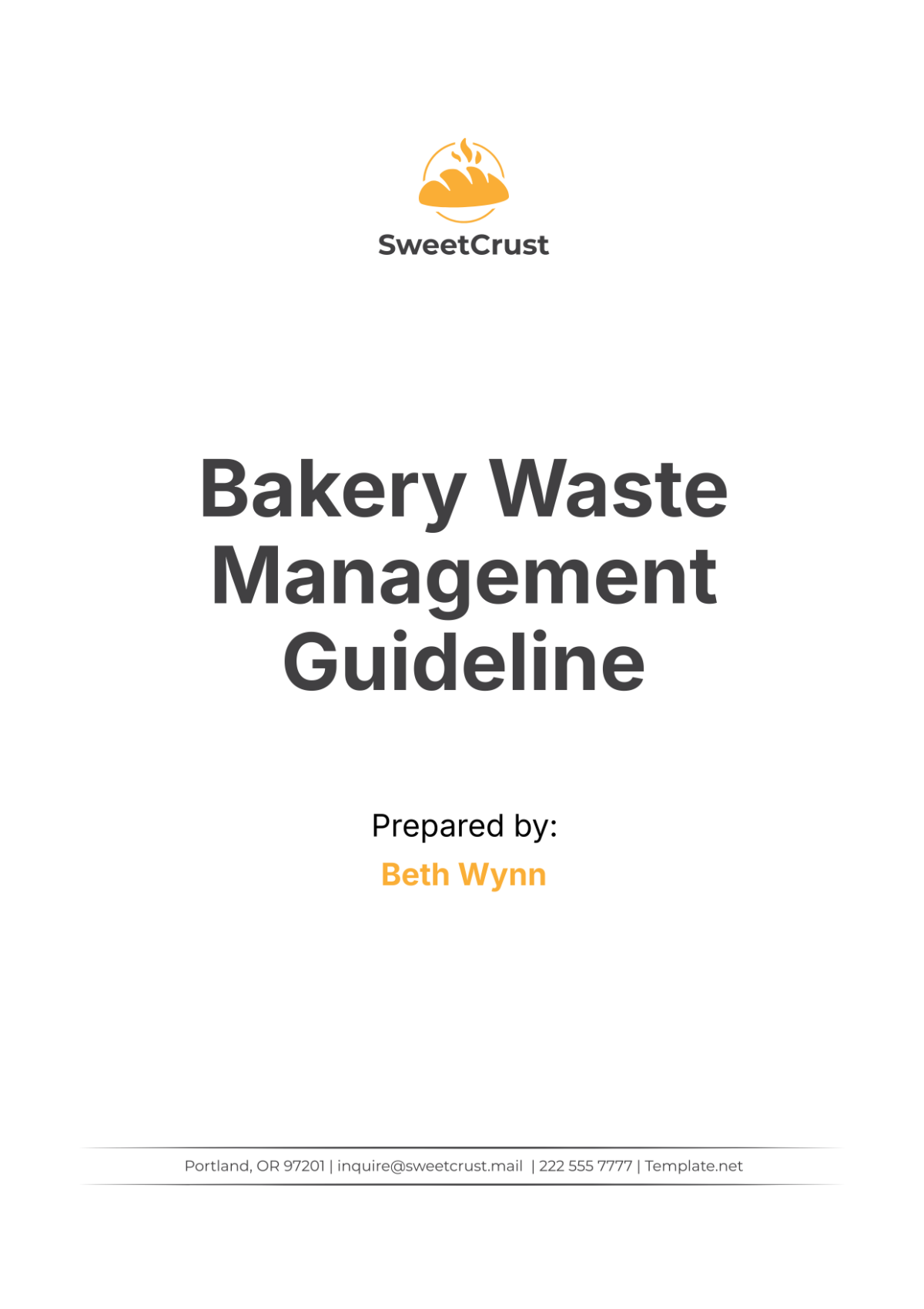Free Bakery Waste Management Guideline

I. Introduction
A. Purpose
The purpose of this Bakery Waste Management Guideline is to provide a comprehensive approach to minimize waste generation, optimize waste segregation and disposal methods, and ensure compliance with environmental regulations at [Your Company Name]. Effective waste management is crucial to maintaining a sustainable bakery operation and reducing environmental impact.
B. Scope
This guideline applies to all employees at [Your Company Name] involved in the production, packaging, and disposal of bakery products. It covers procedures for waste reduction, segregation, storage, and disposal, ensuring that all practices are in line with local and national environmental regulations.
C. Objectives
Minimize Waste Generation: Implement strategies to reduce waste at the source. This includes optimizing production processes and improving inventory management.
Optimize Waste Segregation: Ensure proper segregation of different types of waste to facilitate recycling and proper disposal. This includes separating organic waste, recyclables, and non-recyclables.
Ensure Compliance: Adhere to all relevant environmental regulations and guidelines. Regularly review and update waste management practices to ensure ongoing compliance.
II. Waste Reduction Strategies
A. Inventory Management
Accurate Forecasting: Use accurate sales forecasts to guide production planning. This helps minimize overproduction and waste.
Just-in-Time Inventory: Implement just-in-time inventory practices to reduce excess stock. This approach ensures that ingredients and products are used before they expire.
Supplier Collaboration: Work with suppliers to optimize order quantities and delivery schedules. This helps reduce the risk of spoilage and waste.
B. Production Efficiency
Process Optimization: Regularly review and optimize production processes to minimize waste. This includes improving equipment efficiency and reducing production errors.
Batch Size Management: Adjust batch sizes based on demand to prevent overproduction. Smaller, more frequent batches can help reduce waste.
Employee Training: Provide training to employees on efficient production techniques. Well-trained staff can help identify and implement waste reduction strategies.
C. Product Design
Sustainable Packaging: Use eco-friendly packaging materials that are recyclable or compostable. This helps reduce the environmental impact of packaging waste.
Product Shelf Life: Design products with an extended shelf life to reduce spoilage. This can be achieved through improved recipes and storage methods.
Portion Control: Offer products in various portion sizes to cater to different customer needs. This can help reduce food waste from uneaten portions.
III. Waste Segregation and Storage
Proper segregation and storage are essential for effective waste management. The following table outlines the key categories of waste and their respective segregation and storage methods:
No. | Waste Category | Description | Storage Method |
|---|---|---|---|
1 | Organic Waste | Food scraps and biodegradable items | Compost bins or designated containers |
2 | Recyclable Waste | Paper, cardboard, plastics, glass | Separate recycling bins |
3 | Non-Recyclable Waste | Contaminated or mixed waste | General waste bins |
4 | Hazardous Waste | Chemicals, cleaning agents | Secure, labeled containers |
A. Organic Waste
Compost Bins: Use designated compost bins for organic waste. Composting helps reduce landfill waste and produces useful compost for gardening.
Regular Collection: Schedule regular collection of organic waste to prevent odors and pests. Frequent collection ensures a clean and hygienic environment.
Education: Educate employees on what can and cannot be composted. Proper education helps ensure that only appropriate materials are placed in compost bins.
B. Recyclable Waste
Clear Labeling: Clearly label recycling bins to indicate the types of materials accepted. Clear labeling helps prevent contamination of recyclables.
Cleaning Recyclables: Rinse recyclable containers before placing them in bins. Clean recyclables are easier to process and reduce the risk of contamination.
Bin Placement: Place recycling bins in convenient locations throughout the bakery. Accessible bins encourage employees to recycle more frequently.
C. Non-Recyclable Waste
General Waste Bins: Use general waste bins for non-recyclable and contaminated waste. These bins should be emptied regularly to maintain cleanliness.
Contamination Prevention: Educate employees on what should not be placed in general waste bins. Proper education helps reduce contamination of recyclables.
Waste Minimization: Encourage employees to minimize the amount of non-recyclable waste generated. This can be achieved through conscious consumption and waste reduction practices.
D. Hazardous Waste
Secure Storage: Store hazardous waste in secure, labeled containers. Proper storage helps prevent accidents and environmental contamination.
Disposal Procedures: Follow specific disposal procedures for hazardous waste. This includes using licensed disposal services and complying with regulations.
Training: Provide training to employees on handling and disposing of hazardous waste. Proper training helps ensure safety and compliance.
IV. Waste Disposal Methods
A. Organic Waste Disposal
Composting: Send organic waste to a composting facility or use on-site composting systems. Composting converts waste into valuable compost for agricultural use.
Animal Feed: Donate suitable food scraps to local farms for animal feed. This reduces waste and supports local agriculture.
Biogas Production: Explore biogas production from organic waste. Biogas systems convert waste into renewable energy.
B. Recyclable Waste Disposal
Recycling Facilities: Partner with local recycling facilities for the disposal of recyclable waste. Proper disposal ensures that materials are recycled effectively.
Community Programs: Participate in community recycling programs. These programs can provide additional support and resources for recycling efforts.
Waste Audits: Conduct regular waste audits to identify opportunities for improving recycling rates. Waste audits help track progress and identify areas for improvement.
C. Non-Recyclable Waste Disposal
Landfill Disposal: Use landfill disposal as a last resort for non-recyclable waste. Minimize the amount of waste sent to landfills through waste reduction efforts.
Waste-to-Energy: Explore waste-to-energy options for non-recyclable waste. Waste-to-energy facilities convert waste into usable energy.
Vendor Partnerships: Partner with waste disposal vendors for efficient and compliant disposal. Reliable vendors ensure that waste is managed responsibly.
D. Hazardous Waste Disposal
Licensed Vendors: Use licensed hazardous waste disposal vendors. Licensed vendors ensure safe and compliant disposal.
Regulatory Compliance: Follow all regulations for hazardous waste disposal. Compliance ensures that hazardous materials are managed safely.
Record Keeping: Maintain detailed records of hazardous waste disposal. Records provide a reference for compliance and reporting.
V. Waste Reduction Initiatives
The following table outlines various waste reduction initiatives and their implementation methods. These initiatives aim to reduce waste generation and promote sustainability.
No. | Initiative | Description | Implementation Method |
|---|---|---|---|
1 | Food Donation | Donate surplus food to local charities. | Establish partnerships with charities |
2 | Packaging Reduction | Reduce packaging materials. | Use eco-friendly and minimal packaging |
3 | Employee Engagement | Involve employees in waste reduction efforts. | Conduct training and awareness programs |
4 | Sustainable Sourcing | Source ingredients from sustainable suppliers. | Partner with certified suppliers |
A. Food Donation
Partnerships: Establish partnerships with local charities for food donation. Regular donations help reduce food waste and support the community.
Food Safety: Ensure that donated food meets safety standards. Proper handling and storage are essential for maintaining food quality.
Tracking Donations: Track food donations to measure impact and identify opportunities for improvement. Tracking helps demonstrate the benefits of the donation program.
B. Packaging Reduction
Eco-Friendly Materials: Use eco-friendly packaging materials that are recyclable or compostable. Sustainable packaging reduces environmental impact.
Minimal Packaging: Design packaging to use the minimal amount of material needed. Reducing packaging material helps lower waste and costs.
Supplier Collaboration: Work with suppliers to reduce packaging on delivered goods. Supplier collaboration can help identify and implement packaging reduction opportunities.
C. Employee Engagement
Training Programs: Conduct regular training programs on waste reduction practices. Training helps employees understand their role in waste management.
Incentive Programs: Implement incentive programs to encourage waste reduction. Incentives can motivate employees to actively participate in waste reduction efforts.
Awareness Campaigns: Run awareness campaigns to highlight the importance of waste reduction. Campaigns can include posters, newsletters, and workshops.
D. Sustainable Sourcing
Certified Suppliers: Partner with suppliers who have sustainability certifications. Certified suppliers demonstrate a commitment to environmental responsibility.
Local Sourcing: Source ingredients locally to reduce transportation emissions and support local businesses. Local sourcing can also ensure fresher ingredients.
Supplier Audits: Conduct regular audits of suppliers to ensure compliance with sustainability standards. Audits help maintain supplier accountability.
VI. Waste Monitoring and Reporting
The following table outlines the steps involved in waste monitoring and reporting. Regular monitoring helps track progress and identify areas for improvement.
No. | Step | Description | Frequency |
|---|---|---|---|
1 | Waste Tracking | Track the amount and type of waste generated. | Daily |
2 | Data Analysis | Analyze waste data to identify trends. | Monthly |
3 | Reporting | Report waste data to management. | Quarterly |
4 | Feedback Collection | Collect feedback on waste management practices. | Annually |
A. Waste Tracking
Daily Logging: Log the amount and type of waste generated daily. Daily tracking provides accurate data for analysis.
Category Breakdown: Break down waste into categories for detailed tracking. Detailed tracking helps identify specific areas for improvement.
Electronic Records: Use electronic records for waste tracking. Electronic records are easier to manage and analyze.
B. Data Analysis
Trend Identification: Analyze waste data to identify trends and patterns. Understanding trends helps target areas for waste reduction.
Performance Metrics: Use performance metrics to evaluate waste management efforts. Metrics provide a basis for measuring success and identifying areas for improvement.
Benchmarking: Compare waste data against industry benchmarks. Benchmarking helps set realistic goals and measure progress.
C. Reporting
Quarterly Reports: Prepare quarterly reports on waste management performance. Regular reporting keeps management informed and engaged.
Key Insights: Highlight key insights and areas for improvement in reports. Clear insights help drive action and improvement.
Action Plans: Develop action plans based on report findings. Action plans provide a roadmap for addressing identified issues.
D. Feedback Collection
Employee Surveys: Conduct annual surveys to collect employee feedback on waste management practices. Surveys provide valuable insights from those directly involved.
Stakeholder Input: Gather input from key stakeholders, including suppliers and customers. Stakeholder feedback helps identify opportunities for improvement.
Continuous Improvement: Use feedback to drive continuous improvement in waste management practices. Ongoing improvement helps maintain effectiveness and relevance.
VII. Environmental Compliance
A. Regulatory Requirements
Local Regulations: Comply with local waste management regulations. Local regulations provide specific guidelines for waste disposal and management.
National Standards: Adhere to national environmental standards. National standards ensure consistent and comprehensive compliance.
Regular Audits: Conduct regular audits to ensure compliance with regulations. Audits help identify and address compliance issues.
B. Environmental Certifications
Certification Programs: Participate in environmental certification programs. Certification programs recognize and validate sustainable practices.
Continuous Improvement: Continuously improve practices to maintain certifications. Ongoing improvement helps sustain certification status.
Documentation: Maintain detailed documentation for certification audits. Proper documentation supports successful certification and re-certification.
C. Training and Awareness
Regulatory Training: Provide training on relevant regulations and standards. Training ensures that employees understand and comply with requirements.
Awareness Programs: Implement awareness programs to highlight the importance of environmental compliance. Awareness programs can include workshops and informational materials.
Regular Updates: Keep employees updated on changes to regulations and standards. Regular updates help ensure ongoing compliance.
D. Reporting Requirements
Compliance Reporting: Prepare and submit required compliance reports. Timely reporting ensures adherence to regulatory requirements.
Incident Reporting: Report any incidents or non-compliance issues promptly. Prompt reporting helps address issues quickly and prevent recurrence.
Record Keeping: Maintain comprehensive records of compliance activities. Records provide a reference for audits and reporting.
VIII. Waste Management Equipment and Supplies
Proper equipment and supplies are essential for efficient waste handling and disposal. The following table outlines the key equipment and supplies required for effective waste management:
No. | Equipment/Supplies | Description | Usage |
|---|---|---|---|
1 | Compost Bins | Bins for collecting organic waste. | Daily |
2 | Recycling Bins | Bins for collecting recyclable waste. | Daily |
3 | General Waste Bins | Bins for collecting non-recyclable waste. | Daily |
4 | Hazardous Waste Containers | Secure containers for hazardous waste. | As needed |
A. Compost Bins
Size and Capacity: Select compost bins of appropriate size and capacity. Adequate size ensures that bins can accommodate daily waste volumes.
Location: Place compost bins in convenient locations for easy access. Convenient placement encourages proper use.
Maintenance: Regularly clean and maintain compost bins. Proper maintenance prevents odors and pests.
B. Recycling Bins
Labeling: Clearly label recycling bins to indicate accepted materials. Clear labeling helps prevent contamination.
Durability: Choose durable recycling bins that can withstand daily use. Durable bins ensure long-term functionality.
Accessibility: Place recycling bins in accessible locations. Accessibility encourages regular recycling.
C. General Waste Bins
Volume: Use general waste bins with sufficient volume for daily waste. Adequate volume prevents overflow and maintains cleanliness.
Segregation: Ensure that general waste bins are used only for non-recyclable waste. Proper segregation supports effective waste management.
Emptying Frequency: Schedule regular emptying of general waste bins. Frequent emptying maintains hygiene and prevents odors.
D. Hazardous Waste Containers
Safety Features: Use hazardous waste containers with safety features such as secure lids and labels. Safety features prevent accidents and contamination.
Compliance: Ensure that hazardous waste containers comply with regulatory requirements. Compliance ensures safe and legal disposal.
Storage: Store hazardous waste containers in designated areas. Proper storage minimizes risks and ensures safety.
IX. Training and Compliance
A. Employee Training
Initial Training: Provide initial training to all new employees on waste management practices. Initial training ensures that employees start with a strong understanding of procedures.
Refresher Training: Conduct regular refresher training sessions. Refresher training keeps employees updated on any changes and reinforces best practices.
Training Materials: Develop comprehensive training materials, including manuals and videos. Well-prepared materials support effective training.
B. Compliance Monitoring
Compliance Audits: Conduct regular compliance audits to ensure adherence to waste management guidelines. Audits identify areas for improvement and ensure ongoing compliance.
Performance Reviews: Include waste management performance in employee reviews. Performance reviews hold employees accountable and encourage adherence to guidelines.
Feedback Mechanism: Implement a feedback mechanism for employees to report issues or suggest improvements. Feedback helps identify problems and opportunities for improvement.
C. Continuous Improvement
Regular Review: Regularly review waste management practices and guidelines. Ongoing review ensures that practices remain effective and relevant.
Best Practices: Stay updated on industry best practices and incorporate them into our guidelines. Adopting best practices helps improve waste management.
Innovation: Encourage innovation in waste management practices. Innovative approaches can lead to more effective and sustainable solutions.
By following this comprehensive Bakery Waste Management Guideline, [Your Company Name] can minimize waste, optimize waste segregation and disposal methods, and ensure compliance with environmental regulations, thereby contributing to a sustainable and environmentally responsible bakery operation.
- 100% Customizable, free editor
- Access 1 Million+ Templates, photo’s & graphics
- Download or share as a template
- Click and replace photos, graphics, text, backgrounds
- Resize, crop, AI write & more
- Access advanced editor
Implement effective waste management practices with the Bakery Waste Management Guideline Template! Available on Template.net, this customizable and editable template provides structured guidelines for minimizing waste. The advanced AI Editor Tool allows you to adapt the guidelines to your bakery's unique operations, promoting sustainability and efficiency while reducing environmental impact!





























